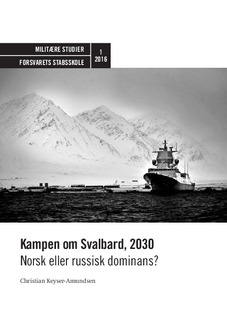| dc.contributor.author | Keyser-Amundsen, Christian | |
| dc.date.accessioned | 2016-02-29T13:39:27Z | |
| dc.date.available | 2016-02-29T13:39:27Z | |
| dc.date.issued | 2016 | |
| dc.identifier.issn | 1894-2547 | |
| dc.identifier.uri | http://hdl.handle.net/11250/2380941 | |
| dc.description.abstract | This thesis addresses the contribution and role of the Royal Norwegian Navy in a crisis situation in the High North as well as the capability and capacity challenges it faces meeting the potential threats in the region. The study highlights the consequences of the completion of the Russian State Armaments Programme on the Navy’s ability to counter a Russian security threat against Norwegian sovereignty over the Svalbard Archipelago. To address these problems, a future scenario in 2030 is outlined, involving a simultaneous incident in the Baltics and a potential spillover to the High North. The study’s main findings are the severe consequences of modern conventional precision-guided missiles on a surface fleet’s ability to perform in a contested theatre of operations, as well as the vulnerability of Norwegian naval forces due to a limited number of bases. Submarines equipped with long range anti-surface and land-attack capability are major assets to establish a military threshold against Russian aggression. In addition, the self-protection measures of the surface combatants have to improve significantly to allow safe operations in a future threat environment. | nb_NO |
| dc.publisher | Forsvarets stabsskole/Forsvarets høgskole | nb_NO |
| dc.relation.ispartofseries | Militære studier;1/2016 | |
| dc.subject | marine | nb_NO |
| dc.subject | Svalbard | nb_NO |
| dc.subject | nordområdene | nb_NO |
| dc.subject | sikkerhetspolitikk | nb_NO |
| dc.subject | Russland | nb_NO |
| dc.title | Kampen om Svalbard, 2030: Norsk eller russisk dominans | nb_NO |
| dc.type | Research report | nb_NO |
| dc.source.pagenumber | 99 | nb_NO |
